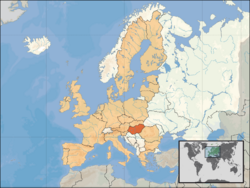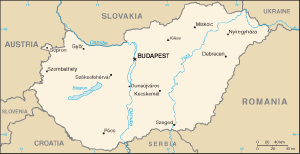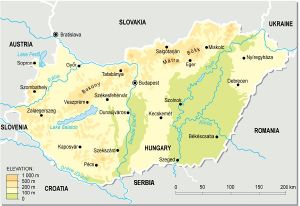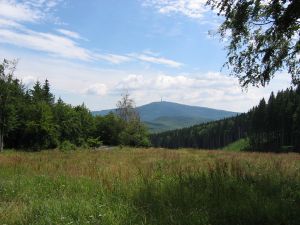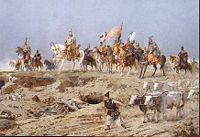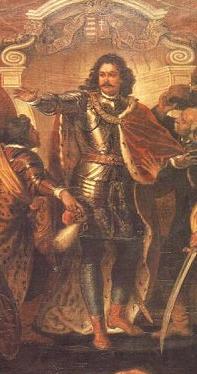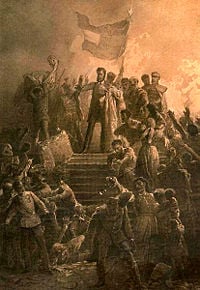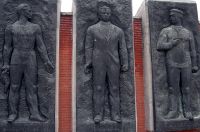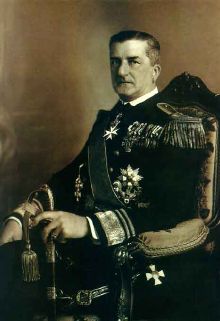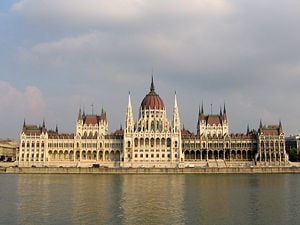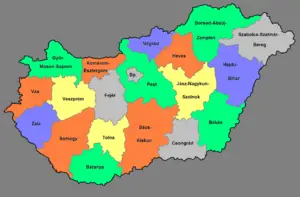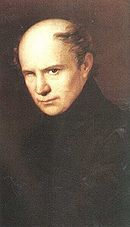Hungary
| Magyar Köztársaság Republic of Hungary |
||||||
|---|---|---|---|---|---|---|
|
||||||
| Motto: none Historically Regnum Mariae Patronae Hungariae (Latin) "Kingdom of Mary the Patroness of Hungary" |
||||||
| Anthem: Himnusz ("Isten, áldd meg a magyart") "Hymn" ("God, bless the Hungarians") |
||||||
| Location of Hungary (orange) – on the European continent (camel white) – in the European Union (camel) [Legend] |
||||||
| Capital (and largest city) | Budapest 47°26′N 19°15′E | |||||
| Official languages | Hungarian (Magyar) | |||||
| Demonym | Hungarian | |||||
| Government | Parliamentary republic | |||||
| - | President | László Sólyom | ||||
| - | Prime minister | Ferenc Gyurcsány | ||||
| Foundation | ||||||
| - | Kingdom of Hungary | December 1000 | ||||
| EU accession | May 1 2004 | |||||
| Area | ||||||
| - | Total | 93,030 km² (109th) 35,919 sq mi |
||||
| - | Water (%) | 0.74% | ||||
| Population | ||||||
| - | 2007 estimate | 10,053,000 [1] (79th) | ||||
| - | 2001 census | 10,198,315 | ||||
| - | Density | 109/km² (92nd) 282/sq mi |
||||
| GDP (PPP) | 2007 estimate | |||||
| - | Total | $208.157 billion[2] (48th) | ||||
| - | Per capita | $20,700[2] (39th) | ||||
| Gini (2002) | 24.96 (low) (3rd) | |||||
| Currency | Forint (HUF) |
|||||
| Time zone | CET (UTC+1) | |||||
| - | Summer (DST) | CEST (UTC+2) | ||||
| Internet TLD | .hu1 | |||||
| Calling code | +36 | |||||
| 1 | Also .eu as part of the European Union. | |||||
Hungary (Hungarian: Magyarország), officially in English the Republic of Hungary (Magyar Köztársaság, is a landlocked country in the Carpathian Basin of Central Europe.
Hungary gained widespread international attention during its Communist era (1945-1989)regarding the Revolution of 1956 and the seminal move of opening its border with Austria in 1989, thus accelerating the collapse of the Eastern Bloc. The present form of government is Parliamentary Republic (1989-).
Geography
Hungary has 1403 miles (2258 kilometers of boundaries, shared with Austria to the west, Serbia, Croatia and Slovenia to the south and southwest, Romania to the southeast, the Ukraine to the northeast, and Slovakia to the north. With a land area of 35,919 square miles (93,030 square kilometers), Hungary is slightly smaller than the state of Indiana in the United States.
Slightly more than one half of Hungary's landscape consists of flat to rolling plains of the Carpathian Basin: the most important plain regions include the Little Hungarian Plain in the west, and the Great Hungarian Plain in the southeast. Transdanubia is a primarily hilly region with a terrain varied by low mountains. These include the very eastern stretch of the Alps, Alpokalja, in the west of the country, the Transdanubian Medium Mountains, in the central region of Transdanubia, and the Mecsek Mountains and Villány Mountains in the south.
The highest mountains of the country are located in the Carpathians: these lie in the northern parts, in a wide band along the Slovakian border (highest point: the Kékes at 3326 feet (1,014 meters)
Hungary has a continental climate, with cold, cloudy, humid winters and warm to hot summers. Temperature extremes are about 110°F (42°C) in the summer and −20°F (−29°C) in the winter. Average temperature in the summer is 81°F to 95°F (27°C to 35°C) and in the winter it is 32°F to 5°F (0°C to −15°C). The average yearly rainfall is approximately 24 inches (600 millimetres). A small, southern region of the country near Pécs enjoys a reputation for a Mediterranean climate, but in reality it is only slightly warmer than the rest of the country and still receives snow during the winter.
Hungary is divided in two by its main waterway, the Danube (Duna); other large rivers include the Tisza and Dráva. The second largest lake in the Carpathian Basin is the artificial Lake Tisza (Tisza-tó).
Despite its relatively small size, Hungary is home to nine World Heritage Sites, including the only historic wine region in the world declared such (Tokaj-Hegyalja), and five UNESCO Biosphere reserves. The country is home to the second largest thermal lake in the world (Lake Hévíz), the largest lake in Central Europe (Lake Balaton), and the largest remaining grasslands in Central Europe (Hortobágy).
Oak is the predominant deciduous tree, and various conifers grow in the mountains. Deer, boar, hare, and mouflon abound. A variety of birds breed and migrate from the Great Plain.
Natural resources include bauxite, coal, natural gas, fertile soils, and arable land.
Environmental issues include the upgrading of Hungary's standards in waste management, energy efficiency, and air, soil, and water pollution to meet European Union requirements.
Budapest is the capital city of Hungary and the country's principal political, cultural, commercial, industrial and transportation centre. Budapest had population of 1,696,128 in 2007.
History
The land before the Magyars
(from intro) The territory was already inhabited in the early Paleolithic. Following a Celtic (after c. 450 B.C.E.) and a Roman (9 B.C.E. - c. 4th Century) period, the foundation of Hungary was laid in the late Ninth Century by the Magyar chieftain Árpád, who after having settled in the Carpathian Basin led the people from paganism toward Roman Catholicism. In December, 1000, Árpád's great grandson, Stephen ascended to the throne with a crown sent from Rome by Pope Sylvester II. The kingdom and nation of Hungary was thus born. The Kingdom of Hungary existed with minor interruptions for more than 900 years, and at various points was regarded as one of the cultural centers of Europe. xxx In the time of the Roman Empire, the region west of the Danube river was known as Pannonia. After the Western Roman Empire collapsed under the stress of the migration of Germanic tribes and Carpian pressure, the Migration Period continued bringing many invaders to Europe. Among the first to arrive were the Huns, who built up a powerful empire under Attila. It is currently believed that the origin of the name "Hungary" does not come from the Central Asian nomadic invaders called the Huns, but rather originated from a later, 7th century Bulgar alliance called On-Ogour, which in Old Turkish meant "(the) Ten Arrows"[3][4]. After Hunnish rule faded, the Germanic Ostrogoths then the Lombards ruled in Pannonia, and the Gepids ruled in the eastern part of the Carpathian Basin for about 100 years, during which the Slavic tribes began migrating into the region. In the 560s, the Slavs were supplanted by a Turkic/Mongol group from Central Asia, the Avars,[5] who maintained their supremacy of the land for more than two centuries. The Franks under Charlemagne from the west and the Bulgars from the southeast managed to overthrow the Avars in the early 9th century. However, the Franks soon retreated, and the Slavonic kingdom of Great Moravia and the Balaton Principality assumed control of much of Pannonia until the end of the century. The Magyars migrated to Hungary in the late 9th century.
Medieval Hungary (896 – 1526)
Árpád was the Magyar leader whom sources name as the single leader who led the conquering Hungarian tribes to the territory of the Carpathian Basin in the 9th century. A later defeat at the Battle of Lechfeld in 955 signalled an end to raids on foreign territories, and links between the tribes weakened. The ruling prince (fejedelem) Géza of the House of Árpád, who was the ruler of only some of the territory, but the nominal overlord of all seven Magyar tribes, intended to integrate Hungary into Christian (Western) Europe, rebuilding the state according to the Western model. He established a dynasty by naming his son Vajk (later called Stephen) as his successor. This was contrary to the then dominant tradition of the succession of the eldest surviving member of the ruling family. Hungary was established as a Christian kingdom under Stephen I of Hungary, who was crowned in December 1000 C.E. in the capital, Esztergom. He was the son of Géza and thus a descendant of Árpád. By 1006, Stephen had solidified his power, eliminating all rivals who either wanted to follow the old pagan traditions or wanted an alliance with the orthodox Christian Byzantine Empire. Then he started sweeping reforms to convert Hungary into a feudal state, complete with forced Christianisation. What emerged was a strong kingdom that withstood attacks from German kings and Emperors, and nomadic tribes following the Magyars from the East, integrating some of the latter into the population (along with Germans invited to Transylvania and present-day Slovakia, especially after 1242), and subjugating Croatia in 1102.
In 1241/1242, this kingdom received one major blow in the form of the Mongol invasion of Europe: after the defeat of the Hungarian army in the Battle of Muhi, King Béla IV fled, and a large part (though not as great as suspected by historians earlier) of the population died (leading later to the invitation of settlers from neighbours in the West and South) in the ensuing destruction (Tatárjárás). Only strongly fortified cities and abbeys could withstand the assault. As a consequence, after the Mongols retreated, King Béla ordered the construction of stone castles, meant to be defence against a possible second Mongol invasion. These castles proved to be very important later in the long struggle with the Ottoman Empire in the following centuries (from the late 14th century onwards), but their cost indebted the King to the major feudal landlords again, so the royal power reclaimed by Béla IV after his father King András II weakened it (leading to the issue of the so called 'Arany Bulla' Golden Bull in 1222), was lost again.
Árpád's descendants on the male line ruled the country until 1301. Under the kings following the house of Árpád, the Kingdom of Hungary reached its greatest size, yet the major landlords increased greatly their influence – while the Ottoman Turks, confronted the country ever more often. The second Hungarian king in the 'Anjou' Angevin line of Italian origin Louis I the Great (I. or Nagy Lajos, king 1342-1382) extended his rule over territories from the Black Sea to the Adriatic Sea, and temporarily occupied the Kingdom of Naples (after his brother was murdered there by his wife, who was also his cousin). From 1370, the death of Casimir III the Great, he was also king of Poland. The alliance between Casimir and Charles I of Hungary, the father of Louis, was the start of a still lasting Polish-Hungarian friendship. Sigismund, a prince from the Luxembourg line succeeded to the throne by marrying Louis's daughter, Queen Mary, in 1433 even became Sigismund, Holy Roman Emperor – but his rule was marked by territorial losses in the South, the 1396 defeat in a late crusade against the Ottoman Turks at Nicopolis, the open dissent of feudal landlords, the Hussite rebellion in the Czech kingdom (which was also under his rule) and partly in the territory that is now Slovakia, and a major peasant rebellion in Transylvania. The last strong king was the renaissance king Matthias Corvinus. He was the son of the feudal landlord and warlord John Hunyadi, who led the Hungarian troops in the 1456 Siege of Nándorfehérvár. Building on his fathers' vision, the aim of taking on the Ottoman Empire with a strong enough background, Matthias set out to build a great empire, expanding southward and northwest, while he also implemented internal reforms. His army called the 'Fekete Sereg' (black army) accomplished a series of victories also capturing the city of Vienna in 1485.
But after Matthias's death, the weak king Ladislaus II of the Polish/Lithuanian Jagiellon line nominally ruled the areas he conquered except Austria, but real power was in the hand of the nobles. In 1514, two years before Ladislaus' death, there was even a major peasant rebellion in the Pannonian lowlands and parts of Transylvania (called the Dózsa Insurrection [after its Transylvanian leader] or Hungarian Peasant's War), crushed barbarously by the nobles. As central rule degenerated, the stage was set for a defeat at the hands of the Ottoman Empire. In 1521, Nándorfehérvár (today Belgrade) fell, and in 1526, the Hungarian army was destroyed in the Battle of Mohács. Through the centuries the Kingdom of Hungary kept its old "constitution", based on freedom of nobles, privileged people (Saxons, Jász-kuns) and free royal towns such as Buda, Kassa (Košice), Pressburg (Pozsony, today Bratislava), Kolozsvár (today Cluj-Napoca).
Ottoman occupation 1526-1686
After some 150 years of wars with the Ottoman Empire in the south, the Turks conquered parts of Hungary, and continued their expansion until 1556. The Ottomans gained their first decisive victory over the Hungarian army at the Battle of Mohács in 1526. The next decades were characterised by political chaos; the divided Hungarian nobility elected two kings simultaneously, 'Szapolyai János' (1526-1540) and Ferdinand Habsburg (1527-1540), whose armed conflicts weakened the country further. With the conquest of Buda in 1541 by the Turks, Hungary fell into three parts. The north-western part (Present-day Slovakia, western Transdanubia, present-day Burgenland, western Croatia and parts of north-eastern present-day Hungary) remained under the rule of the Habsburgs, and although formally was independent, subsequently became a province of their empire under the informal name Royal Hungary. The Habsburg Emperors were crowned as Kings of Hungary. The eastern part of the kingdom (Partium and Transylvania), in turn, became an independent Principality, and a Turkish vassal state. The remaining central area (mostly present-day Hungary), including the capital of Buda, became a province of the Ottoman Empire. A large part of the area became devastated by permanent warfare. Most smaller settlements disappeared. Rural people could survive only in larger settlements owned directly and protected by the Sultan, in the so called Khaz towns. The Turks were indifferent to the type of Christian religion of their subjects and the Habsburg counter-reformation measures could not reach this area. As a result, the majority of the population of the area became Protestant (Calvinist). In 1686, Austria-led Christian forces reconquered Buda, and in the next few years, all of the country except areas near Timişoara (Temesvár). In the 1699 Treaty of Karlowitz these changes were officially recognized, and in 1718 the entire Kingdom of Hungary was restored from the Ottomans.
Pozsony (Pressburg, today: Bratislava) became the new capital (1536-1784), coronation town (1563-1830) and seat of the Diet (1536-1848) of Hungary. Trnava in turn, became the religious center in 1541. Parallelly, between 1604 and 1711, there was a series of anti-Habsburg (i.e. anti-Austrian) and anti-Catholic (requiring equal rights and freedom for all Christian religions) uprisings, which – with the exception of the last one – took place in Royal Hungary, more exactly on the territory of present-day Slovakia. The uprisings were usually organized from Transylvania. The last one was an uprising led by 'II. Rákóczi Ferenc', who was chosen by the people to be the future king. When Austrians crushed the rebellion in 1711, Rákóczi was in Poland. He later fled to France, finally Turkey, and lived to the end of his life (1735) in nearby Rodosto. Afterwards, to make further armed resistance impossible, the Austrians blew up some castles (most of the castles on the border between the now-reclaimed territories occupied earlier by the Ottomans and Royal Hungary), and allowed peasants to use the stones from most of the others as building material (the végvárs among them).
18th and 19th Century
Much of the 18th Century was characterized by a reconstruction of the country. The Habsburg rulers pursued a re-settlement of ravaged areas with new immigrants from present-day Austria and Germany, from the northern and eastern parts of the country (present-day Slovakia and Romania), and from Serbia. In the final decades of the century, influenced by the French revolution, and in response to attempts at Germanisation by Joseph II (ruled 1780-1790), there emerged a national revival movement in Hungary of the Magyars, but also of all the other non-Magyar nationalities living in the Kingdom of Hungary. During the Napoleonic Wars and afterwards, the Hungarian Diet had not convened for decades. In the 1820s, the Emperor was forced to convene the Diet, and thus a Reform Period began. Nevertheless, its progress was slow, because the nobles insisted on retaining their privileges (no taxation, exclusive voting rights, etc.). Therefore the achievements were mostly of national character (e.g. introduction of Hungarian as the official language of the country, instead of the former Latin). The other nationalities of the country protested against these measures. The first measurements of the population on the area of the Kingdom of Hungary (including Croatia) were performed in the late 18th century. Different estimates based on these measurements put the proportion of the Magyars in the Kingdom (with or without Croatia) at 29% to 42% towards the end of the 18th century. A first thorough research in 1836-40 put the percentage of Magyars at 36-37% (without Croatia 48%) and a census in 1850-51 at 45.4% in all the territory of the Kingdom of Hungary. The official percentages of the other nationalities according to the 1850-51 census (although it was criticised for bias towards the percentage of Hungarians and Germans already at that time) were:
- Slovaks (18.6%)
- Germans (11.8%)
- Romanians (10.1%)
- Serbs and Croats (5.6%)
- Ruthenians (Rusyns) (4.8%)
- Others (3.7%)
The Habsburg Emperors and particularly the chancellor Metternich refused to implement reforms and this led to a national revolution.
The 1848 Revolution (1848-1849) and aftermath
On March 15, 1848, mass demonstrations in Pest and Buda enabled Hungarian reformists to push through a list of 12 demands. Faced with revolution both at home and in Vienna, Austria first had to accept Hungarian demands. Later, under governor Lajos Kossuth and the first Prime minister, Lajos Batthyány, the House of Habsburg was dethroned and the form of government was changed to create the first Republic of Hungary. After the Austrian revolution was suppressed, and Franz Joseph replaced his mentally retarded uncle Ferdinand I as Emperor during the subsequent war, the Magyars (and failed revolutionaries from abroad) had to fight against the Austrian Army, but also against those Serbs, Croats, Slovaks, Romanians and Transylvanian Germans living on the territory of the Kingdom of Hungary, who had their own ethnic-national movements, and were unwilling to accept Hungarian dominance. At the same time, some members of these ethnic groups fought with the Hungarian army, like General János Damjanich, an ethnic Serb who became a Hungarian national hero through his command of the 3rd Hungarian Army Corps. Initially, the Hungarian forces (Honvédség) defeated Austrian armies. To counter the successes of the Hungarian revolutionary army, Franz Joseph asked for help from the "Gendarme of Europe," Czar Nicholas I, whose Russian armies invaded Hungary. The huge army of the Russian Empire and the remnants of the Austrian forces proved too powerful for the Hungarian army, and General Artúr Görgey surrendered in August 1849. Julius Freiherr von Haynau, the leader of the Austrian army, then became governor of Hungary for a few months and on October 6, ordered the execution of 13 leaders of the Hungarian army as well as Prime Minister Batthyány. Lajos Kossuth escaped into exile.
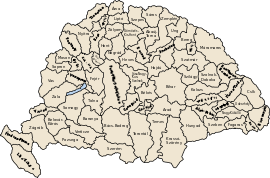
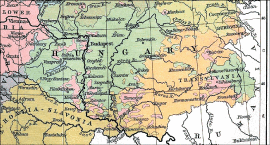
Following the war of 1848-49, the whole country was in "passive resistance". Archduke Albrecht von Habsburg was appointed governor of the Kingdom of Hungary, and this time was remembered for Germanization pursued with the help of Czech officers.
Austria-Hungary (1867-1918)
Due to external and internal problems, reforms seemed inevitable to secure the integrity of the Habsburg Empire. Major military defeats, like the Battle of Königgrätz (1866), forced the Emperor to concede internal reforms. To appease Hungarian separatism, the Emperor made a deal with the Hungarian nobility led by Ferenc Deák, called the Compromise of 1867, by which the dual Monarchy of Austria-Hungary came into existence. The Empire was reorganised into two entities: the mostly western half of the realm, Cisleithania, and the Kingdom of Hungary, Transleithania. The two realms were governed separately with a common ruler and common external, military, and economic policies. The first premier of the Kingdom of Hungary after the Compromise was Count Gyula Andrássy. The Hungarian Constitution was restored, and Franz Joseph was crowned as King of Hungary. The autonomy of the Kingdom was partly achieved. There was also a Hungarian-Croatian Compromise of 1868, as Croatia, an already highly autonomous part of the Kingdom, broadened its constitutional freedom. Hungarian politicians gained strong influence on the Empire's political life and successfully prevented the change of the status quo in favour of other ethnic groups, notably the Czechs and the Southern Slavs. By the turn of the century, the diverse political development of the two realms raised increasing doubts about the political framework of the Monarchy. Attempts to transform the dual monarchy to a trial state or a confederacy remained futile. Besides the German-Magyar, Czech-Magyar conflicts about the future of the dual monarchy, ethnic problems escalated inside the Kingdom of Hungary. The intensifying Hungarian nationalism – intended to strengthen the integrity of the Kingdom – gradually alienated the non-Magyar population (see Magyarization). As a reaction, the already significant Romanian, Serbian and Slovak nationalism further escalated. According to the census in 1910, 54% of the population of the Kingdom (excluding Croatia, mostly autonomous since 1868) used the Hungarian language. The percentages of the next 3 most numerous languages were as follows: Romanian 16%, Slovak 11%, German 10%. In contrast to political problems, the era witnessed an impressive economic development. The formerly backward Kingdom of Hungary become a relatively modern, industrialized country by the turn of the century, although agriculture remained the dominant part of the economy. Many of the state institutions and the administrative system of modern Hungary were established during this period. In First World War Hungary was fighting on the side of Austria. Hungarian troops were fighting against Russians near Premsyl, in Caporetto, where they were thought to be very reliable and been on the forefront, also, Hungarians have pushed back Romanian forces from Transylvania. In 1918, by a notion of Wilson's pacifism, the army of Hungary was dismissed, leaving the country undefended.
Reds and Whites (1918-1919)
In 1918, as a result of defeat in World War I, the Austro-Hungarian Monarchy collapsed. On October 31 1918, the success of the Aster Revolution in Budapest brought the liberal count Mihály Károlyi to power as Prime-Minister. The new government officially declared Hungary an independent republic on November 16, after the end of the war. On 22 November 1918 the Central Romanian Council of Romanians from Transylvania announced to the Hungarian government that it had assumed control of Transylvania. On 1 December 1918 the gathering of Alba Iulia (Gyulafehérvár) proclaimed union of Transylvania with the Kingdom of Romania. By February 1919 the government had lost all popular support, having failed on the domestic and military fronts. On March 21, after the Entente military representative demanded more territorial concessions from Hungary, Károlyi resigned. The Communist Party of Hungary came to power, led by Béla Kun, and proclaimed the Hungarian Soviet Republic. The Communists – "The Reds" – came to power largely thanks to being the only group with an organized fighting force, and they promised that Hungary would regain the lands it had lost (possibly with the help of the Soviet Red Army). The Communists also promised equality and social justice. Initially, Kun's regime achieved some impressive military successes: the Hungarian Red Army, under the lead of the genius strategist, Colonel Aurél Stromfeld, ousted Czechoslovak troops from disputed lands, proclaimed an ephemeral Slovak Soviet Republic, and planned to march against the Romanian army in Transylvania. In terms of domestic policy, the Communist government nationalized industrial and commercial enterprises, socialized housing, transport, banking, medicine, cultural institutions, and all landholdings of more than 400,000 square metres. Still, the popular support of the Communists proved to be short lived. In the aftermath of a coup attempt, the government took a series of reprisals (called the Red Terror) by half-regular and half-militarist detachments (like the "Lenin boys"). A total of 590 people were executed without trial, which alienated much of the population. Land reform took land from the nobles but did not effectively distribute it amongst peasants. The Soviet Red Army was never able to aid the new Hungarian republic. Although it did not lose any battles, the Hungarian Red Army gave up land under pressure from the Entente. In the face of domestic backlash and an advancing Romanian force, Béla Kun and most of his comrades fled to Austria, while Budapest was occupied on August 6. All these events, and in particular the final military defeat, led to a deep feeling of dislike among the general population against the Soviet Union (which had not kept its promise to offer military assistance) and the Jews (since many members of Kun's government were Jewish, making it easy to blame the Jews for the government's mistakes). The new fighting force in Hungary were the Conservative counter-revolutionaries – the "Whites". These, who had been organizing in Vienna and established a counter-government in Szeged, assumed power, led by István Bethlen, a Transylvanian aristocrat, and Miklós Horthy, the former commander in chief of the Austro-Hungarian Navy. Starting in Western Hungary and spreading throughout the country, a White Terror began by other half-regular and half-militarist detachments (as the police power crashed, there were no serious national regular forces and authorities), and many Communists and other leftists were executed without trial. Radical Whites launched pogroms against the Jews, displayed as the cause of all the difficulties of Hungary. The leaving Romanian army pillaged the country – the estimated property damage of their activity was so much that the international peace conference in 1919 did not require Hungary to pay war redemption to Romania. On November 16, with the consent of Romanian forces, Horthy's army marched into Budapest. His government gradually restored security, stopped terror, and set up authorities, but thousands of sympathizers of the Károlyi and Kun regimes were imprisoned. Radical political movements were suppressed. It is now considered by some historians that one of the main reasons for the infamous cold relations between Hungary and Romania is Hungarian resentment at the Romanian intervention and destruction.
The Regency 1920-1944
In January 1920, Hungarian men and women cast the first secret ballots in the country's political history. The voting was not totally democratic, because the entire left-wing either boycotted or was excluded from the voting. A large right-wing majority was elected to a unicameral assembly. In March, the parliament annulled the Compromise of 1867, and it restored the Hungarian monarchy but postponed electing a king until civil disorder had subsided. Instead, Miklos Horthy was elected Regent and was empowered, among other things, to appoint Hungary's Prime Minister, veto legislation, convene or dissolve the parliament, and command the armed forces.
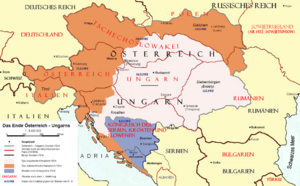
Hungary's signing of the Treaty of Trianon on June 4, 1920, ratified the country's dismemberment. The territorial provisions of the treaty, which ensured continued discord between Hungary and its neighbors, required Hungary to surrender more than two-thirds of its pre-war lands. Nearly one-third of the 10 million ethnic Hungarians found themselves outside the diminished homeland. The country's ethnic composition was left almost homogeneous, Hungarians constituting about 90% of the population, Germans made up about 6%, and Slovaks, Croats, Romanians, Jews and Gypsies accounted for the remainder.[citation needed] New international borders separated Hungary's industrial base from its sources of raw materials and its former markets for agricultural and industrial products. Hungary lost 84% of its timber resources, 43% of its arable land, and 83% of its iron ore.[citation needed] Because most of the country's pre-war industry was concentrated near Budapest, Hungary retained about 51% of its industrial population, 56% of its industry, 82% of its heavy industry, and 70% of its banks.[citation needed] Horthy appointed Count Pál Teleki as Prime Minister in July 1920. His right-wing government issued a numerus clausus law, limiting admission of "political insecure elements" (these were often Jews) to universities and, in order to quiet rural discontent, took initial steps toward fulfilling a promise of major land reform by dividing about 3,850 km² from the largest estates into smallholdings. Teleki's government resigned, however, after the former emperor, Charles IV, unsuccessfully attempted to retake Hungary's throne in March 1921. King Charles's return produced split parties between conservatives who favored a Habsburg restoration and nationalist right-wing radicals who supported election of a Hungarian king. Count István Bethlen, a non-affiliated right-wing member of the parliament, took advantage of this rift forming a new Party of Unity under his leadership. Horthy then appointed Bethlen prime minister. Charles IV died soon after he failed a second time to reclaim the throne in October 1921. (For more detail on Charles's attempts to retake the throne, see Charles IV of Hungary's conflict with Miklós Horthy.)
As prime minister, Bethlen dominated Hungarian politics between 1921 and 1931. He fashioned a political machine by amending the electoral law, providing jobs in the expanding bureaucracy to his supporters, and manipulating elections in rural areas. Bethlen restored order to the country by giving the radical counterrevolutionaries payoffs and government jobs in exchange for ceasing their campaign of terror against Jews and leftists. In 1921, he made a deal with the Social Democrats and trade unions (called Bethlen-Peyer Pact), agreeing, among other things, to legalize their activities and free political prisoners in return for their pledge to refrain from spreading anti-Hungarian propaganda, calling political strikes, and organizing the peasantry. Bethlen brought Hungary into the League of Nations in 1922 and out of international isolation by signing a treaty of friendship with Italy in 1927. The revision of the Treaty of Trianon rose to the top of Hungary's political agenda and the strategy employed by Bethlen consisted by strengthening the economy and building relations with stronger nations. Revision of the treaty had such a broad backing in Hungary that Bethlen used it, at least in part, to deflect criticism of his economic, social, and political policies. The Great Depression induced a drop in the standard of living and the political mood of the country shifted further toward the right. In 1932 Horthy appointed a new prime-minister, Gyula Gömbös, that changed the course of Hungarian policy towards closer cooperation with Germany and started an effort to magyarize the few remaining ethnic minorities in Hungary. Gömbös signed a trade agreement with Germany that drew Hungary's economy out of depression but made Hungary dependent on the German economy for both raw materials and markets. Adolf Hitler used promises of returning lost territories, and threats of military intervention and economic pressure to compel Hungarians into supporting Nazi policies, including those related to Jews. In 1935, Hungary's leading fascist party, Ferenc Szálasi's Arrow Cross, was founded. Gömbös' successor, Kálmán Darányi attempted to appease both the Nazis and Hungarian antisemites by passing the First Jewish Law, which set quotas limiting Jews to 20% of positions in several professions. The law satisfied neither the Nazis nor Hungary's own radicals, and when Darányi resigned in May of 1938, Béla Imrédy was appointed Prime Minister. Imrédy’s attempts to improve Hungary’s diplomatic relations with England initially made him very unpopular with Germany and Italy. Undoubtedly aware of Germany's Anschluss with Austria in March, he realized that he could not afford to alienate Germany and Italy on a long term basis; in the autumn of 1938 his foreign policy became very much pro-German and pro-Italian. [6] Intent on amassing a base of power in Hungarian right wing politics, Imrédy began to suppress political rivals, so the increasingly influential Arrow Cross Party was harassed, and eventually banned by Imrédy’s administration. As Imrédy drifted further to the right, he proposed that the government be reorganized along totalitarian lines and drafted a harsher Second Jewish Law. The new government of Pál Teleki approved the Second Jewish Law, which greatly restricted Jewish employment and defined Jews by race instead of religion. This definition altered the status of those who had formerly converted from Judaism to Christianity.
Hungary in World War II (1941-1945)
In 1941, Hungary participated in the invasion of Yugoslavia, gaining some territory but effectively joining the Axis powers in the process (showing his non-agreement, prime minister Pál Teleki committed suicide). On 22 June 1941, while Germany invaded the Soviet Union in Operation Barbarossa, Hungary declared war on 26 June, entering World War II. In late 1941, the Hungarian troops on the Eastern Front experienced success at the Battle of Uman. By 1943, after the Hungarian Second Army suffered extremely heavy losses at the river Don, the Hungarian government sought to negotiate a surrender with the Allies. On 19 March 1944, as a result of this duplicity, German troops quietly occupied Hungary in what was known as Operation Margarethe. But, by now it was clear that the Hungarians were Germany's "unwilling satellite". On 15 October 1944, Horthy made a weak effort to drive the country out of the war. This time the Germans launched Operation Panzerfaust and Horthy was replaced by a puppet government under the pro-German Prime Minister Ferenc Szálasi. Szálasi and his pro-Nazi Arrow Cross Party remained loyal to the Germans until the end of the war. In late 1944, Hungarian troops on the Eastern Front again experienced success at the Battle of Debrecen. But this was followed immediately by the Soviet invasion of Hungary and the Battle of Budapest. During the German occupation in May-June 1944, the Arrow Cross Party and Hungarian police deported nearly 440,000 Jews, mostly to Auschwitz.[7] Over 400,000 Hungarian Jews were murdered during the Holocaust, as well as tens of thousands of Romani people. Hundreds of Hungarian people were also executed by the Arrow Cross Party for sheltering Jews. The war left Hungary devastated destroying over 60% of the economy and causing huge loss of life. On 13 February 1945, the Hungarian capital city surrendered unconditionally. On 8 May 1945, World War II in Europe officially ended.
Communist era (1945-1989)
Following the fall of Nazi Germany, Soviet troops occupied all of the country and through their influence Hungary gradually became a communist satellite state of the Soviet Union. After 1948, Communist leader Mátyás Rákosi established Stalinist rule in the country complete with forced collectivization and planned economy. The rule of the Rákosi government was nearly unbearable for Hungary's war-torn citizens. This led to the 1956 Hungarian Revolution and Hungary's temporary withdrawal from the Warsaw Pact. The Soviets retaliated massively with military force, sending in over 150,000 troops and 2,500 tanks[8]. Nearly a quarter of a million people left the country during the brief time that the borders were open in 1956. From the 1960s through the late 1980s, Hungary was often satirically referred to as "the happiest barrack" within the Eastern bloc. This was under the autocratic rule of its controversial communist leader, János Kádár. The last Soviet soldier left the country in 1991 thus ending Soviet military presence in Hungary. With the Soviet Union gone the transition to a market economy began.
Hungarian Republic (1989- )
In the late 1980s, Hungary led the movement to dissolve the Warsaw Pact and shifted toward multi-candidate democracy. The MSZMPcommunist party, was still a majority political party, and the election of several independent candidates brought to the forefront increasing pressures for reform within the party. They also transitioned towards a market-oriented economy. On October 23 1989, Mátyás Szűrös declared the Third Hungarian Republic and became interim President. Hungary's first free elections were held in 1990. Following the collapse of the Soviet Union in 1991, Hungary developed closer ties with Western Europe as well as with other Central European countries. It became a member of the Visegrad Group in 1991, joined NATO in 1999, and became a member of the European Union on May 1, 2004.
Government and politics
Hungary is a parliamentary representative democratic republic. According to the 1949 constitution, which was revised in 1972 and again in 1989, and is based on the post-WWII Basic Law of the Federal Republic of Germany, the Prime Minister has a leading role in the executive branch as he selects Cabinet ministers and has the exclusive right to dismiss them.
The President of the Republic, elected by the Parliament every five years, has a largely ceremonial role, choosing the dates of the parliamentary elections. The Prime Minister is elected by Parliament and can only be removed if his successor is elected simultaneously (constructive vote of no confidence). The prime minister selects Cabinet ministers and has the exclusive right to dismiss them. Each Cabinet nominee appears before one or more parliamentary committees in open hearings and must be formally approved by the President.
The unicameral, 386-member National Assembly (Országgyűlés) is the highest organ of state authority and initiates and approves legislation sponsored by the prime minister. Its members are elected for a four-year term. 176 members are elected in single-seat constituencies, 152 by proportional representation in multi-seat constituencies, and 58 so-called compensation seats are distributed based on the number of votes that did not produce a seat in either the single-seat or the multi-seat constituencies. A party must win five percent of the vote to gain representation in the multi-seat constituencies and the compensation seats, not the single-seat constituencies. Suffrage is universal to those aged 18 years and over.
The party system is dominated by the socialist Hungarian Socialist Party and the conservative Hungarian Civic Union or FIDESZ.
An 11-member Constitutional Court has power to challenge legislation on grounds of unconstitutionality. The president of the Supreme Court and the Hungarian civil and penal legal system he leads is independent of the executive branch of government, as are the Attorney General or Chief Prosecutor of Hungary. Several ombudsman offices exist to protect civil, minority, educational and ecological rights in non-judicial matters. The legal system is based German-Austrian legal system. Hungary accepts compulsory International Court of Justice jurisdiction with reservations.
Administrative divisions
Administratively, Hungary is divided into 19 counties. In addition, the capital city (főváros), Budapest, is independent of any county government. The counties and the capital are the 20 NUTS third-level units of Hungary. The counties are further subdivided into 167 subregions (kistérségek), and Budapest is comprised of its own subregion. Since 1996, the counties and City of Budapest have been grouped into 7 regions for statistical and development purposes. These seven regions constitute NUTS' second-level units of Hungary. There are also 23 towns with county rights (singular megyei jogú város), sometimes known as "urban counties" in English (although there is no such term in Hungarian). The local authorities of these towns have extended powers, but these towns belong to the territory of the respective county instead of being independent territorial units.
Military
Honvédség is the name of the Hungarian army. It literally means corps of homeland defenders and was originally used to refer to the revolutionary army established by Lajos Kossuth and the National Defence Committee of the Revolutionary Hungarian Diet in September 1848 during the Hungarian Revolution.
During the Socialist and the Warsaw Pact era (1955–1989), the entire 200,000 strong Southern Group of Forces was garrisoned in Hungary, complete with artillery, tank regiments, air force and missile troops (with nuclear weapons). It was by all means a very capable force that made little contact with the local population. Between 1949 and 1955 there was also a huge effort to build a big Hungarian army. All procedures, disciplines, and equipment were exact copies of the Soviet Red Army in methods and material, but the huge costs collapsed the economy by 1956.
Since the dissolution of the Warsaw Pact Treaty Organization in 1990, Hungary has worked to modernize its armed forces. The Honvédség's largest service is the army, followed by the air force and a small naval contingent that patrols the Danube River, now essentially defunct. The size of the armed forces in 2006 was 45,000, down from over 130,000 in 1989. Mandatory armed service for males was abolished in late 2004, after 136 years of continuous conscription. The government pledged to increase defense spending to 2 percent of GDP to 2006 to bring Hungary's military budget in line with those of NATO countries.
Hungary provided airbases and support for NATO's air campaign against Serbia and has provided military units to serve in Kosovo as part of the NATO-led KFOR operation. Hungary has sent a 300 strong logistics unit to Iraq in order to help the US occupation with armed transport convoys, though public opinion opposed the country's participation in the war.
Hungary is an OECD, NATO, EU, and Schengen member.
Economy
from intro
The Visegrád Group was founded in the Hungarian town of Visegrád in 1991 as a political and economic alliance of three closely related nations (four with the dissolution of Czechoslovakia). Hungary's current goal is becoming a developed country in the foreseeable future. As an indicator of success, the FTSE Group will promote its status to 'advanced emerging market' in 2008.
xxx
Hungary continues to demonstrate economic growth as one of the newest member countries of the European Union (since 2004). The private sector accounts for over 80% of GDP. Hungary gets nearly one third of all foreign direct investment flowing in to Central Europe. Foreign ownership of and investment in Hungarian firms are widespread, with cumulative foreign direct investment totalling more than US$23 billion since 1989. The Hungarian sovereign debt's credit rating is BBB+ as of July 2006, making Hungary the only other country in the EU apart from Poland not to enjoy an A grade score. Inflation and unemployment have been on the rise in the past few years, and they are expected to rise further. Foreign investors' trust in the Hungarian economy has declined, as they deem that the stringency measures planned in the second half of 2006 are not satisfactory, their focus being mainly on increasing the income side rather than curbing government spendings. Economic reform measures such as health care reform, tax reform, and local government financing are being addressed by the present government.
The Hungarian government has expressed a desire to adopt the euro currency between 2010 and 2014[9]. However, foreign analysts widely criticised that date (2010) as highly unrealistic given the current shape of the economy in relation to the Maastricht criteria; their assessments suggest that a date of 2013-2014 for Euro adoption is more realistic.
Demographics
Language
The mother-tongue is Hungarian, part of the Finno-Ugric family, thus one of the few official languages of the European Union that is not of Indo-European origin.
Hungary's population by ethnicity
| Ethnic composition of Hungary | ||||
|---|---|---|---|---|
| Hungarian | 94% | |||
| Roma | 2% | |||
| German | 1.2% | |||
| Slovak | 0.4% | |||
| other | 2.3% | |||
For 95% of the population, mostly Hungarians, the mother tongue is Hungarian, a Finno-Ugric language unrelated to any neighbouring language and distantly related to Finnish and Estonian. Several ethnic minorities exist: Roma (2.1%), Germans (1.2%), Slovaks (0.4%), Croats (0.2%), Romanians (0.1%), Ukrainians (0.1%), and Serbs (0.1%).[10]
The Roma minority
The real number of Roma people, known colloquially as "Gypsies", in Hungary is a disputed question. In the 2001 census, only 190,000 people declared themselves Roma, but experts and Roma organisations estimate that there are between 450,000 and 600,000 Roma living in Hungary.[11] Since World War II, the size of the Roma population has increased rapidly. Today every fifth or sixth newborn Hungarian child belongs to the Roma minority. Estimates based on current demographic trends claim that in 2050 15-20 percent of the population (1.2 million people) will be Roma.[12]
Romas (called cigányok or romák in Hungarian) suffer particular problems in Hungary. Rampant poverty and a subsequent lack of education are the main origin of the bad position of the Romas. Racial prejudice compounds the issue. The traditional lifestyle of the Romas is often an obstacle to integration into society and it it a source of conflicts, especially in the villages. As a result, school segregation is especially acute, with many Roma children sent to classes for pupils with learning disabilities. Currently slightly more than 80% of Roma children complete primary education, but only one third continue studies into the intermediate (secondary) level. This is far lower than the more than 90% proportion of children of non-Roma families who continue studies at an intermediate level. The situation is made still worse by the fact that a large proportion of young Roma are qualified in subjects that provide them only limited chances for employment. Less than 1% of Roma hold higher educational certificates. Their low status on the job market and higher unemployment rates cause poverty, widespread social problems and crime.[13]
Ethnic Hungarians in neighbouring countries
For historical reasons (see Treaty of Trianon), significant Hungarian minority populations can be found in the surrounding countries, notably in Romania (in Transylvania), Slovakia, Serbia (in Vojvodina), Ukraine (in Transcarpathia), Croatia (mainly Slavonia) and Austria (in Burgenland); Slovenia is also host to a number of ethnic Magyars, where Hungarian language has an official status.
Religion in Hungary
| Denominations | Population | % of total |
|---|---|---|
| Christianity | 7,584,115 | 74.4 |
| Catholicism | 5,558,901 | 54.5 |
| Roman Catholics | 5,289,521 | 51.9 |
| Greek Catholics | 268,935 | 2.6 |
| Protestantism | 1,985,576 | 19.47 |
| Calvinists | 1,622,796 | 15.9 |
| Lutherans | 304,705 | 3.0 |
| Baptists | 17,705 | 0.2 |
| Unitarians | 6,541 | 0.1 |
| Other Protestants | 33,829 | 0.3 |
| Orthodoxism | 15,298 | 0.1 |
| Other Christians | 24,340 | 0.2 |
| Judaism | 12,871 | 0.1 |
| Other religions | 13,567 | 0.1 |
| Total religions | 7,610,553 | 74.6 |
| No religion | 1,483,369 | 14.5 |
| Did not wish to answer | 1,034,767 | 10.1 |
| Unknown | 69,566 | 0.7 |
| total | 10,198,315 | 100.00 |
In the past
The majority of Hungarian people became Christian in the 10th century. Hungary's first king, Saint Stephen, took up Western Christianity, although his mother, Sarolt, was baptized in the eastern rite. Hungary remained predominantly Catholic until the 16th century, when the Reformation took place and, as a result, first Lutheranism, then soon afterwards Calvinism became the religion of almost the entire population. In the second half of the 16th century, however, Jesuits led a successful campaign of counterreformation among the Hungarians. Jesuits founded educational institutions, including the oldest university that still exists in Hungary (Péter Pázmány), but they organized so-called missions too in order to promote popular piety. By the 17th century, once again, Hungary became predominantly Catholic. The eastern parts of the country, however, especially around Debrecen ("the Calvinist Vatican") and Transylvania (except the majority of the Székelys), remained predominantly Protestant.
Orthodox Christianity in Hungary has been the religion mainly of some national minorities in the country, notably, Romanians, Rusyns and Ukrainians, Serbs.
Hungary has been the home of a sizable Armenian community as well. They still worship according to the Armenian liturgical rite, but they have reunited with the Church of Rome (Armenian Catholics) under the primacy of the Pope. According to the same pattern, a significant number of Byzantine Rite Christians became re-united with the rest of the Catholic world (Greek Catholics).
Hungary has been the home of a significant number of Jews, especially since the 19th century when many Jews persecuted in Russia found refuge in the Kingdom of Hungary. The largest synagogue in Europe is in Budapest. However, even Hungarian Jews did not escape the Holocaust during World War II, and hundreds of thousands of them were either deported to concentration camps or simply executed.
Today
The 2001 Hungarian Census[14] showed religious adherency to be the following... Roman Catholic 51.9%, Calvinist 15.9%, No Religion 14.5%, refused to answer 10.1%, Lutherian 3%, Greek Catholic 2.6% and other 2%.
According to the most recent Eurobarometer Poll 2005,[15]
- 44% of Hungarian citizens responded that "they believe there is a God".
- 31% answered that "they believe there is some sort of spirit or life force".
- 19% answered that "they do not believe there is any sort of spirit, God, or life force".
Culture
Architecture
In terms of manmade structures, Hungary is home to the largest synagogue in Europe (Great Synagogue), the largest medicinal bath in Europe (Széchenyi Medicinal Bath), the third largest church in Europe (Esztergom Basilica), the second largest territorial abbey in the world (Pannonhalma Archabbey), the second largest Baroque castle in the world (Gödöllő), and the largest Early Christian Necropolis outside Italy (Pécs).
Music

The music of Hungary consists mainly of traditional Hungarian folk music and music by prominent composers such as Liszt, Bartók and Kodály. Hungarian traditional music tends to have a strong dactylic rhythm, as the language is invariably stressed on the first syllable of each word. Hungary also has a number of internationally renowned composers of contemporary classical music, György Ligeti, György Kurtág, Péter Eötvös and Zoltán Jeney among them.
Béla Bartók
One of the greatest Hungarian composers, also among the most significant musicians of the 20th century. His music was invigorated by the themes, modes, and rhythmic patterns of the Hungarian and neighboring folk music traditions he studied, which he synthesized with influences from his contemporaries into his own distinctive style. He showed precocious musical ability and began to compose dances at the age of nine. In Bratislava he studied piano under distinguished teachers. From 1907 he became a piano instructor at the Budapest Academy and remained in this post for more than twenty-five years. He began to collect folk music in Hungary's Békés County at a young age. He became interested in other folk traditions, studying the folk music of Romanians, Slovakians, Serbs, Croatians, Bulgarians, Turks, and North Africans as well as Hungarians. The main task of his life was to collect, analyze, and catalogue major portions of the world's folk music. In 1907 he made his first trip to Transylvania to study the Székely people – a distinctive Hungarian-speaking minority of present-day Romania[16].
Franz (Ferenc) Liszt
Born in 1811 in Doborján, Hungary, Franz Liszt was soon recognized to be a child prodigy at the age of six. Tours and many performances generated amazement and praise for the young Liszt by audiences, musicians and Kings. Playing on par with established professionals at age 12 he was fast becoming a sensation. In 1826 his father died and he earned a living by teaching piano lessons in Paris. He traveled all around Europe. In 1835, he traveled to Switzerland where he composed several impressions of the Swiss country. In Portugal he was described as "God of the Piano", and along his journey he performed charity concerts for various causes. He retired from the concert stage in 1847. He settled in Weimar, living in the Altenberg as Court Kapellmeister. He established the Conservatory of Music in Budapest and was elected its first president. Liszt is documented as being the first person to ever attempt using music as therapy after visiting sick and demoralized patients in hospitals. The majority of Liszt's compositions breathe with a human beat of passion rather than a metronomic, or robotic, beat that is many times a slave to pure notation. Liszt released the very heart, soul, and to some people's chagrin, demons of mankind. He developed the transformation of themes, he was the first and true inventor of impressionism and atonal music, well before Debussy and Schoenberg. He was the first to fully orchestrate on the piano, utilizing all its undiscovered resources, he created strikingly original orchestrations utilizing unconventional instruments such as the triangle in Piano Concerto #1, the harp in Dante Symphony and the bass drum in Héroïde Funèbre. He invented the symphonic poem[17].
Zoltán Kodály
He was a prominent Hungarian composer, educator, ethnomusicologist, linguist, author and philosopher. Along with Bartók and Ligeti, he is one of the three major figures in Hungarian music of the 20th century. Kodály's many compositions show a strong affinity with the folk traditions of his country and include ballad operas, orchestral works, chamber music, choral works, songs, folk song arrangements and music for children. As a composer, Kodály did much to bridge the gap between Hungarian folk music and the European art music tradition.
In the early 1900's, Kodály and his colleague Bartók turned their backs on the European music culture of Hungary and focused their attention on their own native folk music traditions. In 1905 they set off on the first of many expeditions to collect and gather traditional Hungarian folk music. Kodaly's work was not immediately accepted by "the establishment" which regarded folk music to be uncultured and unrefined. In reality, the quality of these works caused them to receive worldwide recognition in the field of ethnomusicology. In his later years Kodály was the president of the Hungarian Academy of Sciences, president of the International Folk Music Council, and honorary president of the International Society for Music Education. Outside Central Europe he may be best known for his solmisation method, which is widely used all around the world[18].
Cuisine
Hungarian cuisine is also a prominent feature of Hungarian culture, with traditional dishes such as goulash (gulyás or gulyásleves) a main feature of the Hungarian diet. Dishes are often flavoured with paprika. Stews are often to be found with typical elements such as pork or beef, for example as used in pörkölt.There are also many desserts that are usually flavoured with fruit and pastry based(rétes).Food is a big part of the Hungarian culture and it is viewed often as rude to not accept it when offered.
Science
Hungary is famous for its excellent mathematics education which has trained numerous outstanding scientists. Famous Hungarian mathematicians include Paul Erdős, famed for publishing in over forty languages and whose Erdős numbers are still tracked; János (John) Bolyai, designer of non-Euclidean (or "absolute") geometry in 1831;[19] and John von Neumann, a pioneer of digital computing. Many Hungarian Jewish scientists, including Erdős, von Neumann, Edward Teller, and Eugene Wigner, fled rising anti-Semitism in Europe and made their most famous contributions in the United States.
Hungarians are very proud of their inventions. These include the noiseless match (János Irinyi), Rubik's cube (Ernő Rubik), and the krypton electric bulb (Imre Bródy). A number of other important inventions, including holography (Dennis Gabor), the ballpoint pen (László Bíró), the theory of the hydrogen bomb (Edward Teller), and the BASIC programming language (John Kemeny, with Thomas E. Kurtz),[19] were invented by Hungarians who fled the country prior to World War II.
Literature
Hungarian literature has recently gained some renown outside the borders of Hungary (mostly through translations into German, French and English). Some modern Hungarian authors became increasingly popular in Germany and Italy especially Sándor Márai, Péter Esterházy, Péter Nádas and Imre Kertész. The latter is a contemporary Jewish writer who survived the Holocaust and won the Nobel Prize for literature in 2002. The older classics of Hungarian literature and Hungarian poetry remained almost totally unknown outside Hungary. János Arany, a famous nineteenth century Hungarian poet is still much loved in Hungary (especially his collection of Ballads), among several other "true classics" like Sándor Petőfi, the poet of the Revolution of 1848, Endre Ady, Mihály Babits, Dezső Kosztolányi, Attila József and János Pilinszky. Other well-known Hungarian authors are Zsigmond Móricz, Gyula Illyés, Albert Wass, and Magda Szabó.
Sport
One of the most famous Hungarians is the footballer Ferenc Puskás (1927 – 2006). He scored 84 goals in 85 internationals for Hungary, and 511 goals in 533 matches in the Hungarian and Spanish leagues. Puskás played the 1954 World Cup final against West Germany. In 1958, after the Hungarian Revolution, he emigrated to Spain where he played in the legendary Real Madrid team that also included Alfredo Di Stéfano, and Francisco Gento.
Hungarians are also known for their prowess at water sports, mainly swimming, water polo and canoeing; this can be said to be surprising at first, due to Hungary being landlocked. On the other hand, the presence of two major rivers (the Duna and the Tisza) and a major lake (Balaton) give excellent opportunities to practice these sports. Some of the world's best sabre fencing athletes have historically hailed from Hungary.
See also
|
|
|
|
Template:HungaryPortal
Lists
- List of cities in Hungary
- List of Hungarians
- List of Hungarian rulers
- List of Hungarian writers
- List of colleges in Hungary
- List of universities in Hungary
- Common Hungarian surnames
- Eastern name order used in Hungarian personal names
- Budapestnight100.jpg
Budapest, capital city
- Debrecen400.jpg
Debrecen
- Szeged400.jpg
Szeged
- Hungary-Pecs Main Place.jpg
Pécs
- Gyor24.jpg
Győr
- Diosgyor castle and king louis.jpg
Miskolc
- Kecskeméti Városháza.jpg
Kecskemét
- Szekesfehervar Orb and Episcopal Palace.JPG
Székesfehérvár
- Veszprem Szentharomsagter dny.jpg
Veszprém
- Eger400.jpg
Eger
- Sopron400.jpg
Sopron
- Koszeg400.JPG
Kőszeg
ReferencesISBN links support NWE through referral fees
- ↑ Hungarian Central Statistical Office Retrieved 2007-11-16
- ↑ 2.0 2.1 IMF report retrieved 2007-06-18
- ↑ OSZK.
- ↑ Hungary, Encyclopædia Britannica.
- ↑ The Avar Khaganate
- ↑ Hungary: The Unwilling Satellite John F. Montgomery, Hungary: The Unwilling Satellite. Devin-Adair Company, New York, 1947. Reprint: Simon Publications, 2002.
- ↑ United States Holocaust Memorial Museum; Holocaust Encyclopedia
- ↑ Findley, Carter V., and John Rothney. Twentieth Century World. sixth ed. Boston: Houghton Mifflin, 2006. 278.
- ↑ "Gyurcsány modifies date", Világgazdaság
- ↑ [1]
- ↑ [2]
- ↑ See, for instance, Romani World, where a high estimate of 19.62% is given for 2050.
- ↑ See an abstract of Poverty and Ethnicity: A Cross-Country Study of Roma Poverty in Central Europe. by the World Bank for an overview.
- ↑ [3]
- ↑ Eurobarometer on Social Values, Science and technology 2005 - page 11. Retrieved on 2007-05-05.
- ↑ http://waterfire.fas.is/Hungary/MusicofHungary.php
- ↑ http://waterfire.fas.is/Hungary/MusicofHungary.php
- ↑ http://waterfire.fas.is/Hungary/MusicofHungary.php
- ↑ 19.0 19.1 The Contribution of Hungarians to Universal Culture (includes inventors), Embassy of the Republic of Hungary, Damascus, Syria, 2006.
External links
- Hungary World Fact Book 2007, accessed November 22, 2007.
- Hungary Encyclopaedia Britannica Online, accessed November 22, 2007.
- Official site of the National Assembly
- Official site of the President of Hungary
- Official site of the Prime Minister of Hungary
- History of Hungary: Primary Documents
- History of Hungary – The Corvinus Library
- In The Land of Hagar - The Jews of Hungary – A Virtual Exhibition
- Budapest Photos
- Aerial photography: Hungary
- Artistic photos of Hungary
- Translation of Hungarian literary works - a database
- 1100 photos about the Hungarian countryside - along the long distance path "Countrywide Blue Tour"
- Hungary at the Open Directory Project
- An online gallery of photographs - Szeged, Kőszeg, ...
Credits
New World Encyclopedia writers and editors rewrote and completed the Wikipedia article in accordance with New World Encyclopedia standards. This article abides by terms of the Creative Commons CC-by-sa 3.0 License (CC-by-sa), which may be used and disseminated with proper attribution. Credit is due under the terms of this license that can reference both the New World Encyclopedia contributors and the selfless volunteer contributors of the Wikimedia Foundation. To cite this article click here for a list of acceptable citing formats.The history of earlier contributions by wikipedians is accessible to researchers here:
The history of this article since it was imported to New World Encyclopedia:
Note: Some restrictions may apply to use of individual images which are separately licensed.


